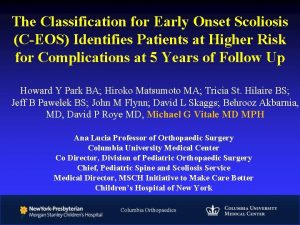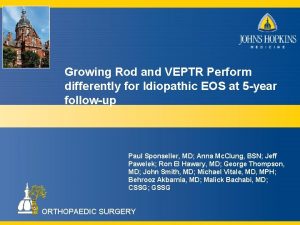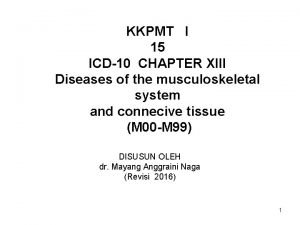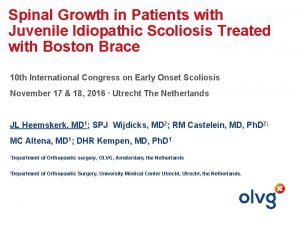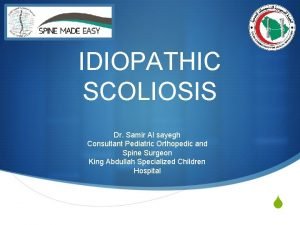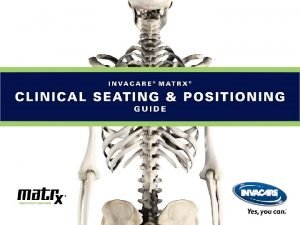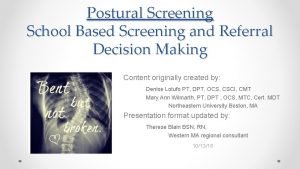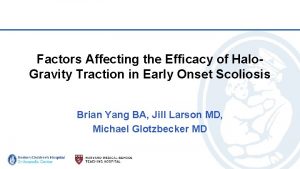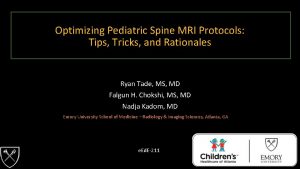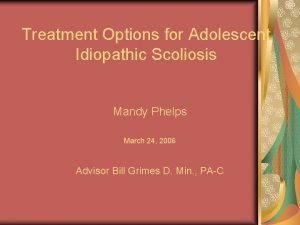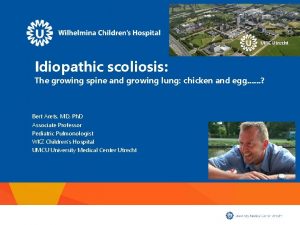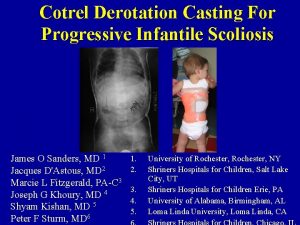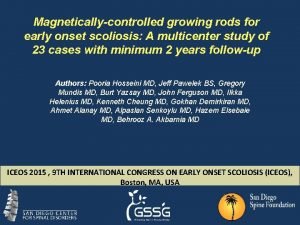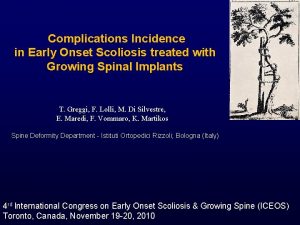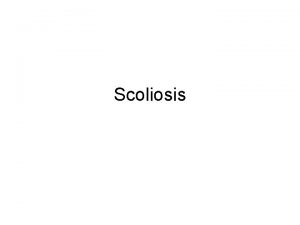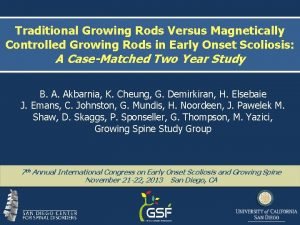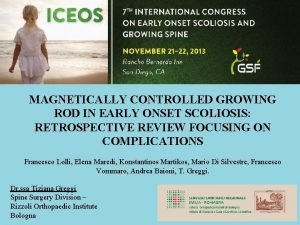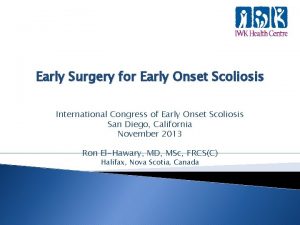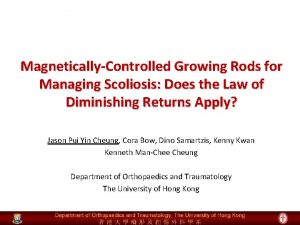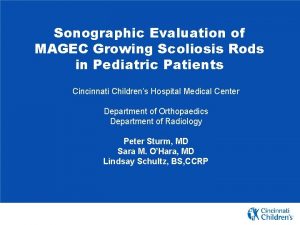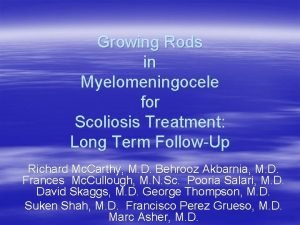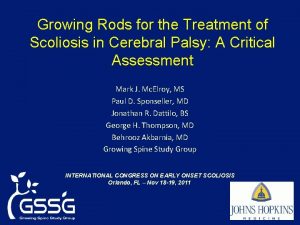EARLY ONSET SCOLIOSIS TREATED WITH GROWING RODS HAS














- Slides: 14

EARLY ONSET SCOLIOSIS TREATED WITH GROWING RODS HAS A GREATER INCREASE IN T 1 -S 1 LENGTH, BETTER COBB CORRECTION, BUT MORE THAN TWICE THE NUMBER OF SURGERIES COMPARED TO SHILLA LINDSAY M. ANDRAS MD ELIZABETH R. A. JOINER BS RICHARD E. MCCARTHY MD SCOTT J. LUHMANN MD PAUL D. SPONSELLER MD JOHN B. EMANS MD DAVID L. SKAGGS MD GROWING SPINE STUDY GROUP

Disclosures • • LM Andras- none ER Joiner- none RE Mc. Carthy- Medtronic (B, C, F) SJ Luhmann- Medtronic Sofamor Danek (A, B, C); Watermark Research (B); Stryker (C); Globus Medical (F) PD Sponseller- De. Puy, A Johnson and Johnson Company (A, B, F); Globus Medical (F); Journal of Bone and Joint Surgery oakstone medical (F) JB Emans- Synthes (B, F); Medtronic Sofamor Danek (B) DL Skaggs-Institutional support from Medtronic, POSNA and SRS (paid to Columbia University) (A); Biomet (B, C, F); Medtronic (B, C, F); Stryker(C); Beach Body LLC( B) Growing Spine Study Group- none 2

Background The Shilla system is an alternative to distraction based growing rod instrumentation • Dual rod construct • Limited fusion at apex • Shilla screws at end that slide along the rods • Allows continued growth without surgical lengthening 3

Study Purpose To compare the treatment of early onset scoliosis with Shilla versus dual growing rod constructs vs 4

Materials and Methods Multicenter retrospective review Inclusion criteria: • Diagnosis of early onset scoliosis • Shilla or dual spine-spine growing rod instrumentation • Minimum two year follow up Exclusion criteria: • Prior instrumentation • Index procedure > 10 yo 5

Materials and Methods 37 Shilla patients were matched with 37 dual growing rod patients from the Growing Spine Study Group database by: • Age at index surgery (+1 year) • Preoperative Cobb angle (+15 o) • Diagnosis (neuromuscular, congenital, idiopathic, syndrome) 6

Results • Mean age at the time of the index procedure was 6. 0 years in the Shilla group and 6. 1 years in the growing rod group • Mean radiographic follow up was 4. 6 years in the Shilla group and 4. 3 years in the growing rod group (p=0. 35) 7

Results: Mean Cobb Angle Shilla Growing Rod P-value (degrees) Post Index Surgery 69 26 72 38 P=0. 3738 P=0. 0002 Final follow up 45 36 P=0. 019 -2 P<0. 001 -36 P=0. 014 Preoperative Change during “growth period” (post index surgery to final follow up) 19 Overall change (from preoperative to final follow up) -24 + 8

Results: Mean T 1 -S 1 Length Shilla (cm) Preoperative 29. 0 26. 5 P=0. 0224 Post Index Surgery 32. 5 30. 0 P=0. 0103 Final follow up 35. 4 35. 2 P=0. 9071 2. 8 5. 3 P=0. 0045 6. 4 8. 7 P=0. 0131 Change during “growth period” (post index surgery to final follow up) Overall change (from preoperative to final follow up) Growing P-value Rod (cm) 9

Results: Surgeries Shilla Growing P-value Rod Additional surgeries 1. 8 (0 -8) 6. 4 (1 -14) p < 0. 001 Overall Complication Rate 1. 9 (0 -7) 1. 2 (0 -9) p = 0. 142 Total number of implant revisions 1. 5 (0 -7) 1. 4(0 -7) p = 0. 8884 Unplanned 1. 3 (0 -6) 0. 4 (0 -6) p = 0. 0078 0. 2(0 -2) p = 0. 0296 0. 8(0 -4) p = 0. 0015 During planned lengthening 0 Construct Maintenance 0. 2(0 -1) 10

Results: Summary Shilla Growing P- value Rod Average change in cobb -24 degrees -35 degrees angle Average change in T 1 -S 1 6. 4 cm 8. 5 cm 0. 019 Total # of surgeries per patient <0. 001 2. 8 7. 0 0. 031 11

Results PREOPERATIVE POSTOPERATIVE FINAL FOLLOWUP 12

Discussion Study Limitations • majority of patients have not reached skeletal maturity or had a definitive fusion • possible selection bias in which technique was performed • Shilla procedure is newer and this group includes initial patients in which surgeons were gaining familiarity with this technique • Retrospective Database 13

Conclusion In this case matched series of EOS patients treated with Shilla versus Growing Rod constructs Less increase in T 1 - S 1 length Similar complication rate Fewer surgeries 14
 Early onset scoliosis classification
Early onset scoliosis classification Veptr growing rods
Veptr growing rods Growing rods
Growing rods X iceos
X iceos Disorder of synovium and tendon
Disorder of synovium and tendon Scoliosis chiropractor seminole county
Scoliosis chiropractor seminole county Dr abdullah sayegh
Dr abdullah sayegh Hyperextesion
Hyperextesion Infantile scoliosis casting
Infantile scoliosis casting School spinal screening worksheet
School spinal screening worksheet Factors affecting traction
Factors affecting traction Mri scoliosis protocol
Mri scoliosis protocol Costodesis
Costodesis Scoliosis
Scoliosis Risser cast scoliosis
Risser cast scoliosis
